|
||||||||||||||||||||||
![Home - Air Power Australia Website [Click for more ...]](APA/APA-Title-Main.png) |
||||||||||||||||||||||
![Sukhoi PAK-FA and Flanker Index Page [Click for more ...]](APA/flanker.png) |
![F-35 Joint Strike Fighter Index Page [Click for more ...]](APA/jsf.png) |
![Weapons Technology Index Page [Click for more ...]](APA/weps.png) |
![News and Media Related Material Index Page [Click for more ...]](APA/media.png) |
|||||||||||||||||||
![Surface to Air Missile Systems / Integrated Air Defence Systems Index Page [Click for more ...]](APA/sams-iads.png) |
![Ballistic Missiles and Missile Defence Page [Click for more ...]](APA/msls-bmd.png) |
![Air Power and National Military Strategy Index Page [Click for more ...]](APA/strategy.png) |
![Military Aviation Historical Topics Index Page [Click for more ...]](APA/history.png)
|
![Intelligence, Surveillance and Reconnaissance and Network Centric Warfare Index Page [Click for more ...]](APA/isr-ncw.png) |
![Information Warfare / Operations and Electronic Warfare Index Page [Click for more ...]](APA/iw.png) |
![Systems and Basic Technology Index Page [Click for more ...]](APA/technology.png) |
![Related Links Index Page [Click for more ...]](APA/links.png) |
|||||||||||||||
![Homepage of Australia's First Online Journal Covering Air Power Issues (ISSN 1832-2433) [Click for more ...]](APA/apa-analyses.png) |
||||||||||||||||||||||
| Last Updated: Mon Jan 27 11:18:09 UTC 2014 | ||||||||||||||||||||||
|
||||||||||||||||||||||
|
PLA Ballistic Missiles
|
|||||||||||||||||||||||||||||||||||||||||||||||||||||||||||||||||||||||||||||||||||||||||||||||||||||||||||||||||||||||||||||||||||||||||||||||||||||||||||||||||||||||||||||||||||||||||||||||||||||||||||||||||||||||||||||||||||||||||||||||||||||||||||||||||||||||||||||||||||||||||||||||||||||||||||||||||||||||||||||||||||||||||||||||||||||||||||||||||||||||||||||||||||||||||||||||||||||||||||||||||||||||||||||||||||||||||||||||||||||||||||||||||||||||||||||||||||||||||||||||||||||||||||||||||||||||||||||||||||||||||||||||||||||||||||||||||||||||||||||||||||||||||||||||||||||||||||||||||||||||||||||||||||
| Technical Report APA-TR-2010-0802 Sean O'Connor, BA, MS (AMU) August 2010 Updated April, 2012 Text © 2009, 2010 Sean O'Connor Layout © 2004 - 2010 Dr Carlo Kopp  |
|||||||||||||||||||||||||||||||||||||||||||||||||||||||||||||||||||||||||||||||||||||||||||||||||||||||||||||||||||||||||||||||||||||||||||||||||||||||||||||||||||||||||||||||||||||||||||||||||||||||||||||||||||||||||||||||||||||||||||||||||||||||||||||||||||||||||||||||||||||||||||||||||||||||||||||||||||||||||||||||||||||||||||||||||||||||||||||||||||||||||||||||||||||||||||||||||||||||||||||||||||||||||||||||||||||||||||||||||||||||||||||||||||||||||||||||||||||||||||||||||||||||||||||||||||||||||||||||||||||||||||||||||||||||||||||||||||||||||||||||||||||||||||||||||||||||||||||||||||||||||||||||||||
 DF-15B TBM TELs during
the 60th Anniversary PLA parade. |
|||||||||||||||||||||||||||||||||||||||||||||||||||||||||||||||||||||||||||||||||||||||||||||||||||||||||||||||||||||||||||||||||||||||||||||||||||||||||||||||||||||||||||||||||||||||||||||||||||||||||||||||||||||||||||||||||||||||||||||||||||||||||||||||||||||||||||||||||||||||||||||||||||||||||||||||||||||||||||||||||||||||||||||||||||||||||||||||||||||||||||||||||||||||||||||||||||||||||||||||||||||||||||||||||||||||||||||||||||||||||||||||||||||||||||||||||||||||||||||||||||||||||||||||||||||||||||||||||||||||||||||||||||||||||||||||||||||||||||||||||||||||||||||||||||||||||||||||||||||||||||||||||||
|
|
|||||||||||||||||||||||||||||||||||||||||||||||||||||||||||||||||||||||||||||||||||||||||||||||||||||||||||||||||||||||||||||||||||||||||||||||||||||||||||||||||||||||||||||||||||||||||||||||||||||||||||||||||||||||||||||||||||||||||||||||||||||||||||||||||||||||||||||||||||||||||||||||||||||||||||||||||||||||||||||||||||||||||||||||||||||||||||||||||||||||||||||||||||||||||||||||||||||||||||||||||||||||||||||||||||||||||||||||||||||||||||||||||||||||||||||||||||||||||||||||||||||||||||||||||||||||||||||||||||||||||||||||||||||||||||||||||||||||||||||||||||||||||||||||||||||||||||||||||||||||||||||||||||
BackgroundChina's ballistic missile force represents one of the most
significant collections of threat systems in the Pacific theater of
operations. Recently, China has made a concerted effort to develop
highly-mobile off-road TELs (Transporter Erector Launcher) for its
shorter-range weapons, and has
deployed ICBMs (Inter Continental Ballistic Missiles) on road-mobile
TELs. An increase in longer range weapons
and more survivable launch systems have enabled China's ballistic
missile forces to significantly increase their effectiveness to hold at
risk targets far outside the WESTPAC theater, including Europe and the
United States. |
|||||||||||||||||||||||||||||||||||||||||||||||||||||||||||||||||||||||||||||||||||||||||||||||||||||||||||||||||||||||||||||||||||||||||||||||||||||||||||||||||||||||||||||||||||||||||||||||||||||||||||||||||||||||||||||||||||||||||||||||||||||||||||||||||||||||||||||||||||||||||||||||||||||||||||||||||||||||||||||||||||||||||||||||||||||||||||||||||||||||||||||||||||||||||||||||||||||||||||||||||||||||||||||||||||||||||||||||||||||||||||||||||||||||||||||||||||||||||||||||||||||||||||||||||||||||||||||||||||||||||||||||||||||||||||||||||||||||||||||||||||||||||||||||||||||||||||||||||||||||||||||||||||
Table: US DoD, Military Power of the People’s Republic of China 2010, Page 66. |
|||||||||||||||||||||||||||||||||||||||||||||||||||||||||||||||||||||||||||||||||||||||||||||||||||||||||||||||||||||||||||||||||||||||||||||||||||||||||||||||||||||||||||||||||||||||||||||||||||||||||||||||||||||||||||||||||||||||||||||||||||||||||||||||||||||||||||||||||||||||||||||||||||||||||||||||||||||||||||||||||||||||||||||||||||||||||||||||||||||||||||||||||||||||||||||||||||||||||||||||||||||||||||||||||||||||||||||||||||||||||||||||||||||||||||||||||||||||||||||||||||||||||||||||||||||||||||||||||||||||||||||||||||||||||||||||||||||||||||||||||||||||||||||||||||||||||||||||||||||||||||||||||||
|
|||||||||||||||||||||||||||||||||||||||||||||||||||||||||||||||||||||||||||||||||||||||||||||||||||||||||||||||||||||||||||||||||||||||||||||||||||||||||||||||||||||||||||||||||||||||||||||||||||||||||||||||||||||||||||||||||||||||||||||||||||||||||||||||||||||||||||||||||||||||||||||||||||||||||||||||||||||||||||||||||||||||||||||||||||||||||||||||||||||||||||||||||||||||||||||||||||||||||||||||||||||||||||||||||||||||||||||||||||||||||||||||||||||||||||||||||||||||||||||||||||||||||||||||||||||||||||||||||||||||||||||||||||||||||||||||||||||||||||||||||||||||||||||||||||||||||||||||||||||||||||||||||||
Intercontinental
Ballistic
Missiles
|
|||||||||||||||||||||||||||||||||||||||||||||||||||||||||||||||||||||||||||||||||||||||||||||||||||||||||||||||||||||||||||||||||||||||||||||||||||||||||||||||||||||||||||||||||||||||||||||||||||||||||||||||||||||||||||||||||||||||||||||||||||||||||||||||||||||||||||||||||||||||||||||||||||||||||||||||||||||||||||||||||||||||||||||||||||||||||||||||||||||||||||||||||||||||||||||||||||||||||||||||||||||||||||||||||||||||||||||||||||||||||||||||||||||||||||||||||||||||||||||||||||||||||||||||||||||||||||||||||||||||||||||||||||||||||||||||||||||||||||||||||||||||||||||||||||||||||||||||||||||||||||||||||||
DF-31/DF-31A/CSS-10
/
JL-2/CSS-NX-13
|
|||||||||||||||||||||||||||||||||||||||||||||||||||||||||||||||||||||||||||||||||||||||||||||||||||||||||||||||||||||||||||||||||||||||||||||||||||||||||||||||||||||||||||||||||||||||||||||||||||||||||||||||||||||||||||||||||||||||||||||||||||||||||||||||||||||||||||||||||||||||||||||||||||||||||||||||||||||||||||||||||||||||||||||||||||||||||||||||||||||||||||||||||||||||||||||||||||||||||||||||||||||||||||||||||||||||||||||||||||||||||||||||||||||||||||||||||||||||||||||||||||||||||||||||||||||||||||||||||||||||||||||||||||||||||||||||||||||||||||||||||||||||||||||||||||||||||||||||||||||||||||||||||||
| Principal Specifications | Notes1 |
|
| Category |
ICBM
mobile |
|
| Maximum
Range
[km] |
7,200
DF-31/JL-2;
11,200
DF-31A |
|
| Apogee
[km] |
1,000 |
|
| Vehicle Guidance | Inertial |
|
| RV
CEP
@
Maximum
Range
[m] |
- |
|
| RV
Warhead
Type
/
Mass
[-/kg] |
700
kg;
1
x
250
kT |
|
| Configuration |
3
Stage
Solid
Propellant |
|
| Length,
Total
[m] |
11.0 |
|
| Span/Dia,
Total
[m] |
2.0 |
|
| Launch
Weight,
Total
[kg] |
20,000 |
|
| First
Stage
Length |
8.0
/
JL-2-1 |
|
| First
Stage
Mass,
Launch/Empty
[kg] |
-/- |
|
| First
Stage
Motor
Type/Config |
DF-31-1 Solid Propellant Rocket | |
| First
Stage
Propellant |
N-15
NEPE
(Nitrate
Ester
Plasticized Polyether) |
|
| Second Stage Length | 4.0
/
DF-31-3 |
|
| Second Stage Mass, Launch/Empty [kg] | -/- |
|
| Second Stage Motor Type/Config | KT-1-2
Solid
Propellant
Rocket |
|
| Second Stage Propellant | N-15
NEPE
(Nitrate
Ester
Plasticized Polyether) |
|
| Third Stage Length | 2.0
/
DF-31-3 |
|
| Third Stage Mass, Launch/Empty [kg] | -/- |
|
| Third Stage Motor Type/Config | JL-2-3 Solid Propellant Rocket | |
| Third Stage Propellant | N-15
NEPE
(Nitrate
Ester
Plasticized Polyether) |
|

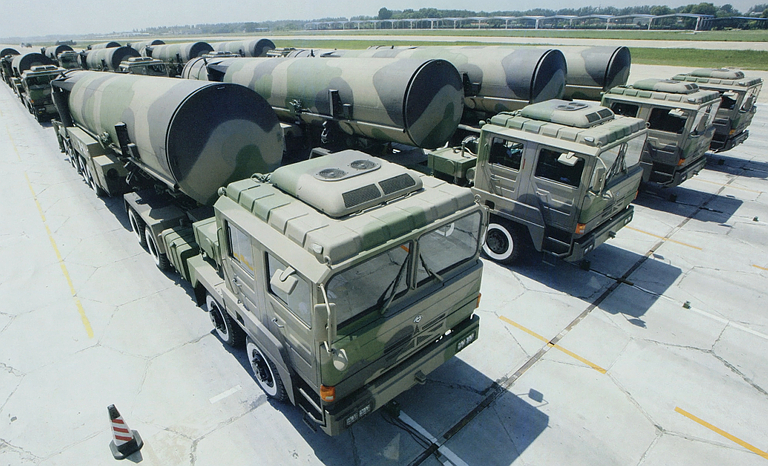
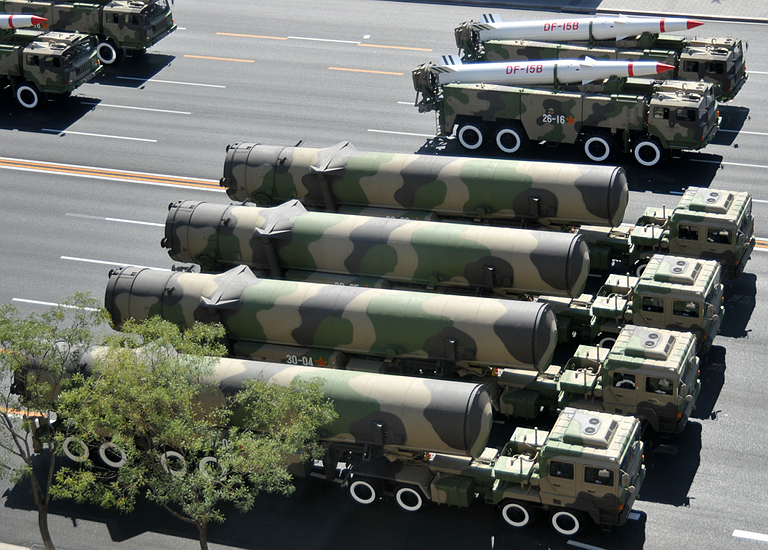
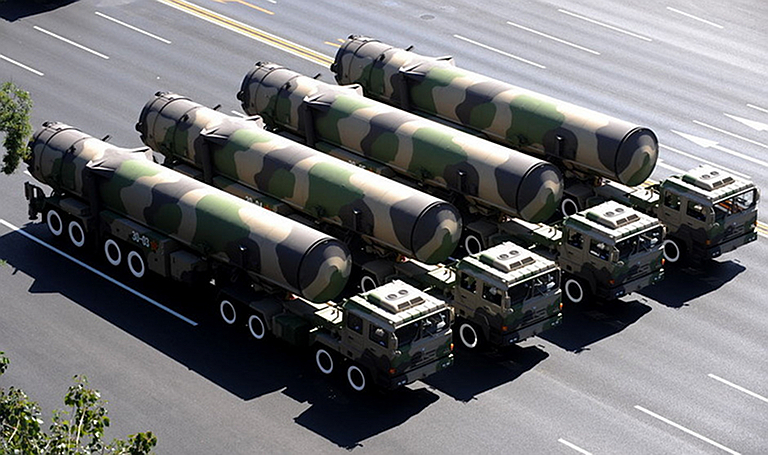
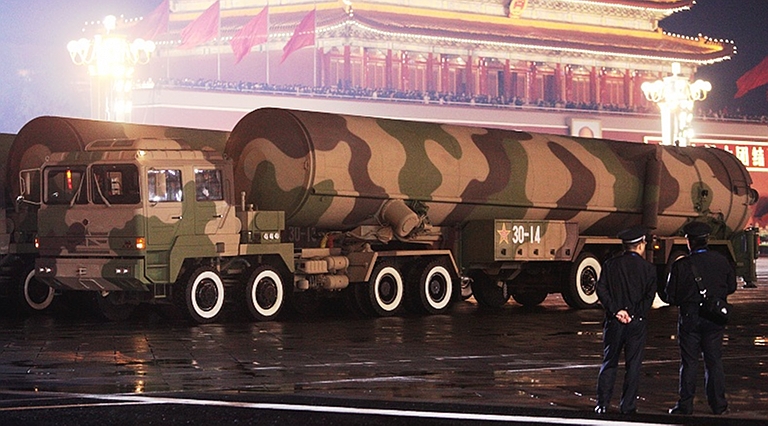

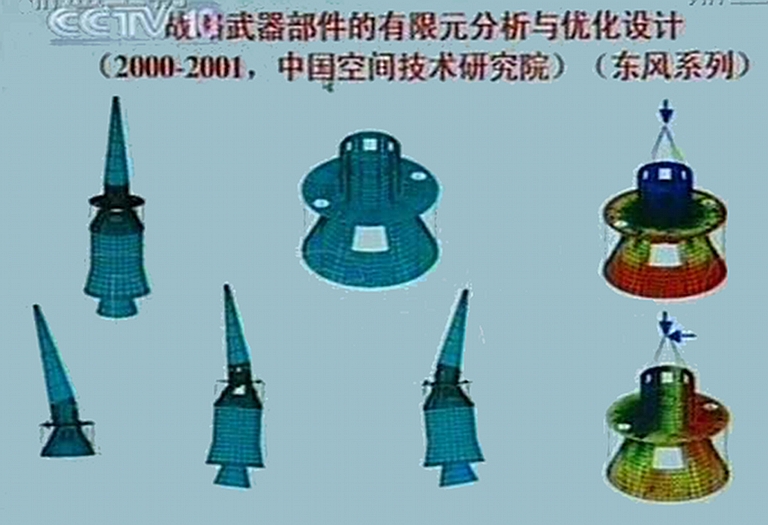
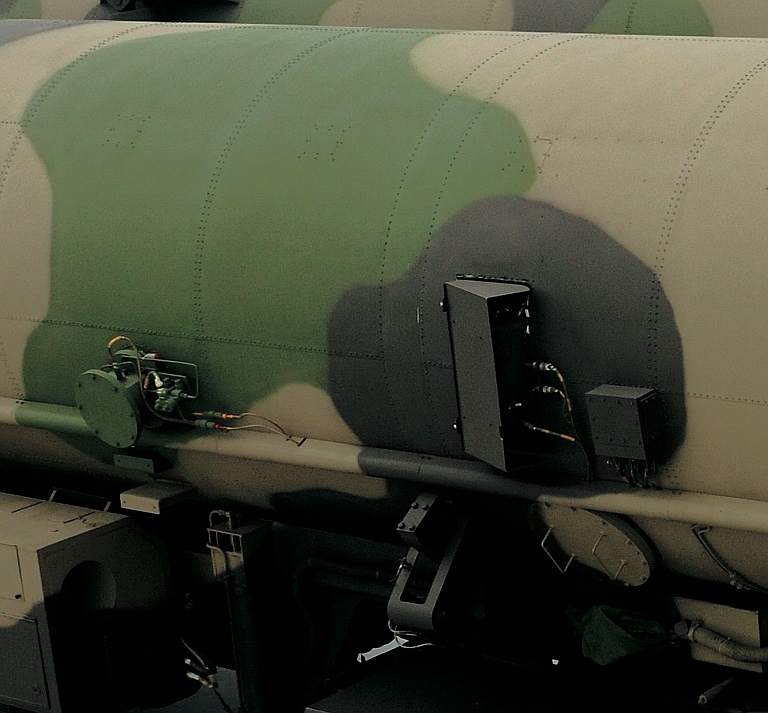


DF-5/DF-5A / CSS-4

Between 1983 and 1986, work progressed on improving the range of the DF-5, resulting in the DF-5A being fielded. Today, 20 silo-based DF-5A ICBMs compose a large portion of the PLA's nuclear deterrent force, the initial DF-5s having been upgraded or withdrawn. The DF-5A is currently a single-warhead weapon, but MIRV research for the DF-5 began as early as 1983 as part of the DF-5A program.
| Principal Specifications | Notes1 | |
| Category |
ICBM
silo
launched |
|
| Maximum
Range
[km] |
12,000
-
15,000 |
|
| Apogee
[km] |
- |
|
| Vehicle Guidance | Inertial |
|
| RV
CEP
@
Maximum
Range
[m] |
est
500
-
3,500 |
|
| RV
Warhead
Type
/
Mass
[-/kg] |
3,000
-
3,200
/
1
x
2.0
-
5.0
MT |
|
| Configuration |
3
Stage
Liquid
Propellant |
|
| Length,
Total
[m] |
32.6 |
|
| Dia,
Total
[m] |
3.35 |
|
| Launch
Weight,
Total
[kg] |
183,000 |
|
| First
Stage
Length |
- |
|
| First
Stage
Mass,
Launch/Empty
[kg] |
- |
|
| First
Stage
Motor
Type/Config |
Liquid Propellant Rocket | |
| First
Stage
Propellant |
N2O2/UDMH |
|
| Second Stage Length | - |
|
| Second Stage Mass, Launch/Empty [kg] | - |
|
| Second Stage Motor Type/Config | Liquid Propellant Rocket | |
| Second Stage Propellant | N2O2/UDMH | |
| Third Stage Length | - |
|
| Third Stage Mass, Launch/Empty [kg] | - |
|
| Third Stage Motor Type/Config | Liquid Propellant Rocket | |
| Third Stage Propellant | N2O2/UDMH | |

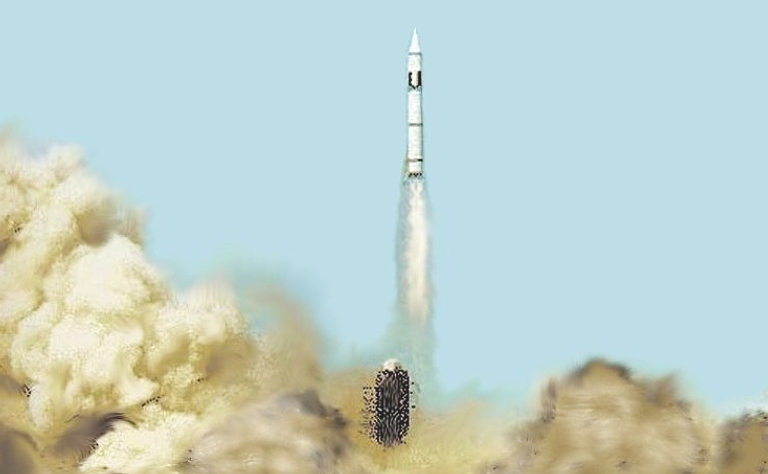
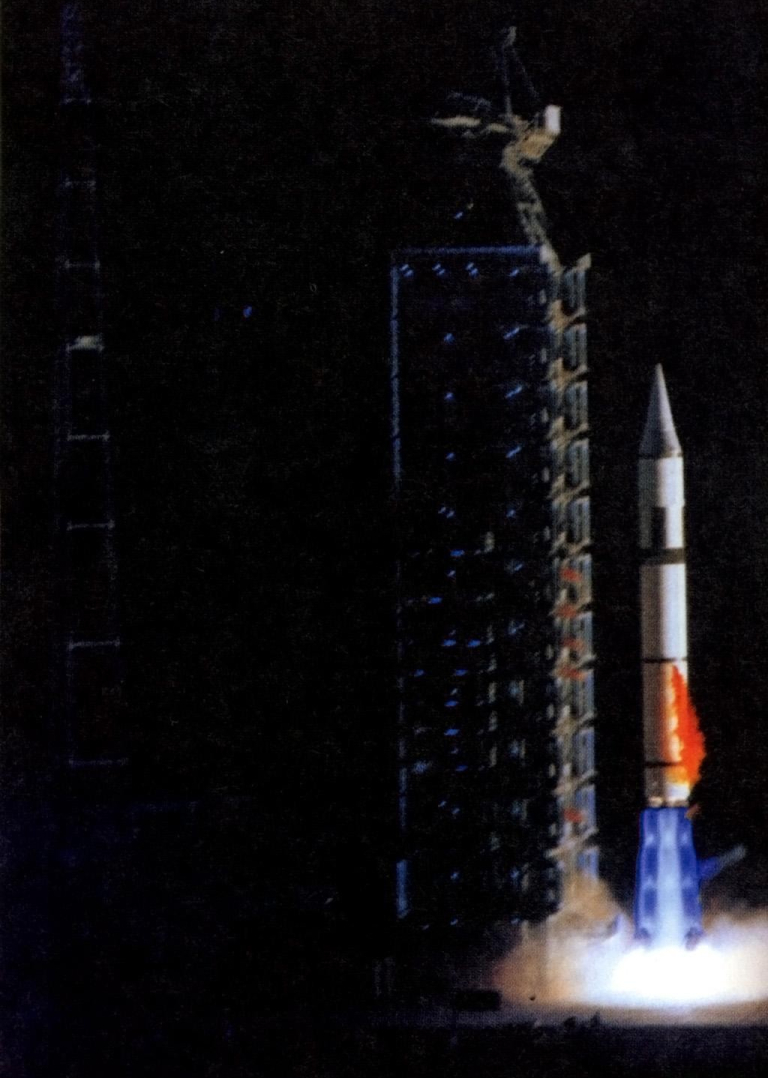

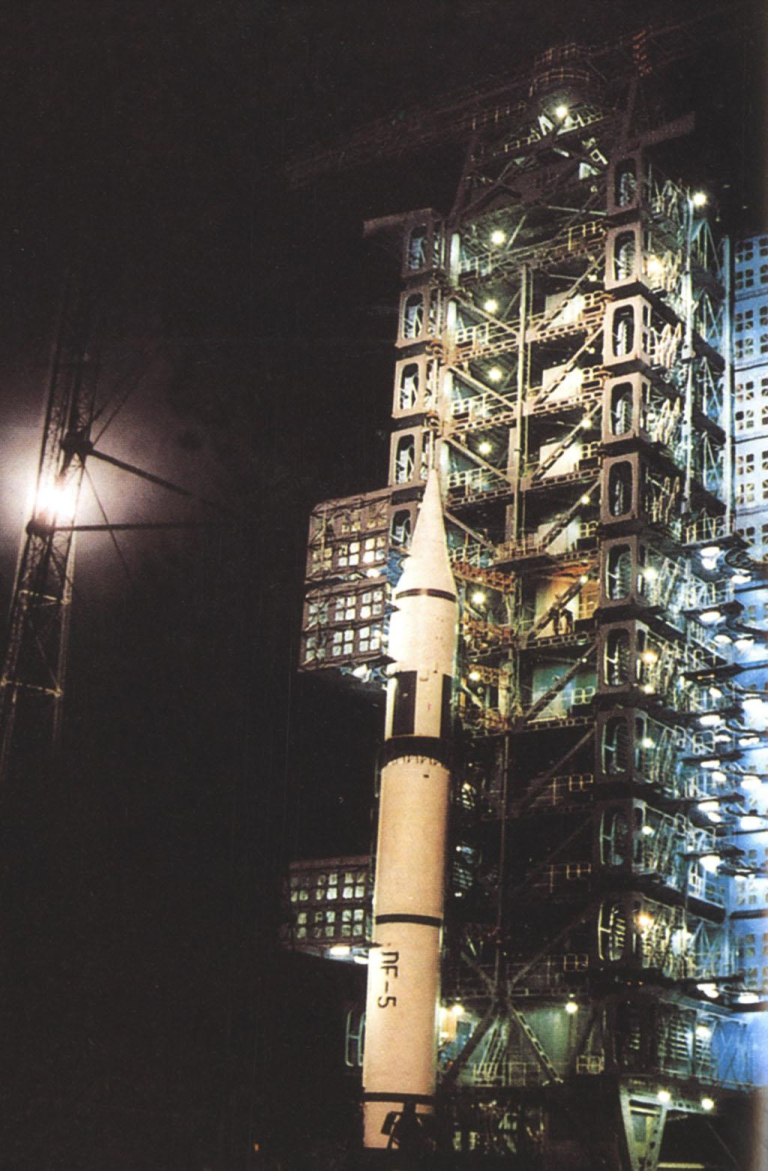
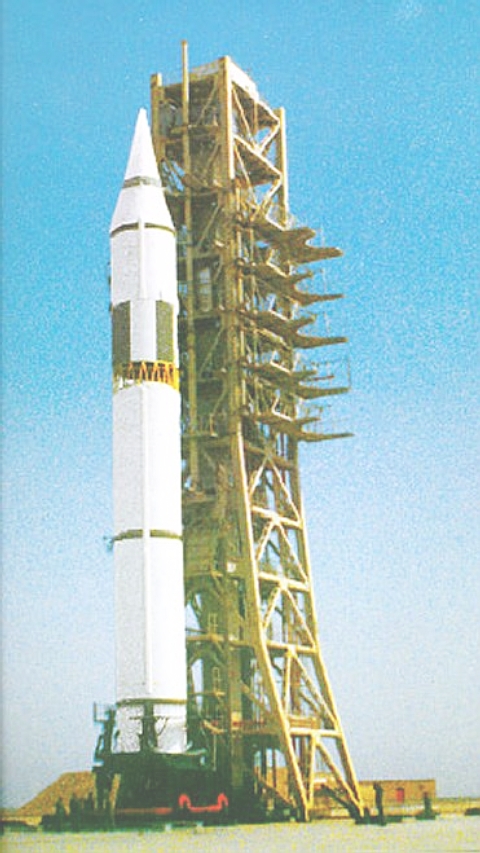

DF-4 / CSS-3

DF-4 ballistic missile erected (PLA).
Development began in 1965, but suffered from a focus on the DF-5 ICBM. The DF-4 was redesigned in 1970 to be able to reach Moscow, with the missile achieving IOC in 1980. The US DoD claims that 15-20 DF-4s remain in service, supported by 10-15 launchers. These weapons employ a rollout-to-launch system, being prepared inside UGFs (Under-Ground Facility) before rollout and erection on prepared launch pads.
| Principal Specifications | Notes1 | |
| Category |
Intermediate
Range
Ballistic
Missile |
|
| Maximum
Range
[km] |
4,760 |
|
| Apogee
[km] |
500 |
|
| Vehicle Guidance | Inertial |
|
| RV
CEP
@
Maximum
Range
[m] |
1,190 |
|
| RV
Warhead
Type
/
Mass
[-/kg] |
1
x
Thermonuclear
3.3
MT
/
2,190 |
|
| Configuration |
2
Stage
Liquid
Rocket |
|
| Length,
Total
[m] |
28.05 |
|
| Span,
Total
[m] |
2.74 |
|
| Launch
Weight,
Total
[kg] |
82,000 |
|
| First
Stage
Length |
17.84 |
CZ-YF-2 |
| First
Stage
Mass,
Launch/Empty
[kg] |
4,100/64,100 |
|
| First
Stage
Motor
Type/Config |
4
x
YF-2A
/
Liquid
Propellant
Rocket |
1,224.575
kN |
| First
Stage
Propellant |
IRFNA/UDMH |
|
| Second Stage Length | 5.35 |
CZ-1-2 |
| Second Stage Mass, Launch/Empty [kg] | 2,700/15,000 |
|
| Second Stage Motor Type/Config | 1 x YF-2A / Liquid Propellant Rocket | 306.143
kN |
| Second Stage Propellant | IRFNA/UDMH |
|
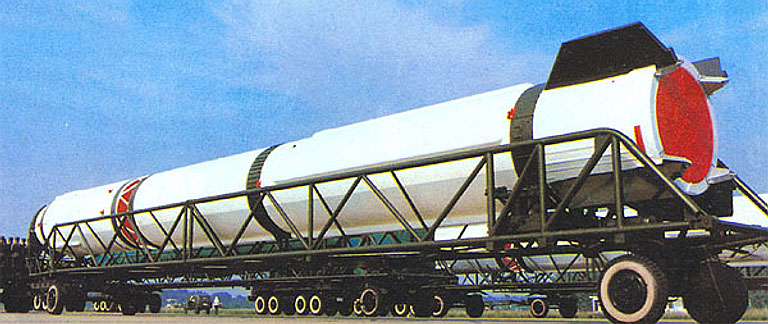

Intermediate Range Ballistic Missiles
DF-21A/C/D/DF-25
/ CSS-5
/ JL-1/1A / CSS-N-3 / KT-1/SC-19 ASAT

DF-21C carried by high mobility WS-2400 TEL.
Four land-based DF-21 variants are operational, and the derivative JL-1 SLBM arms the Type 092 SSBN. DF-21 development began in the late 1960s. Initially, the focus was on developing the JL-1 SLBM variant. Actual DF-21 development did not proceed until 1978, following the successful testing of the JL-1's solid rocket motor. This represented the first successful solid-rocket ballistic missile design in China.
While the JL-1 is considered a weapon of dubious effectiveness due to its short range and the limitations of the Type 092 SSBN, the DF-21 family developed into a host of effective weapons.
The initial DF-21 was deployed in 1988, with the enhanced DF-21A following in 1996. Primary improvements in the DF-21A included increased accuracy and extended range. The development of the DF-21C began in 1984 as the DF-25, intended to offer the ability to carry a much larger warhead. The DF-21C also introduced a new WS-2400 TEL, conferring a measure of off-road mobility not present in the original towed launchers used by the DF-21 and DF-21A.
While the DF-21 and DF-21A were nuclear strike weapons, the DF-21C is employed as a conventional weapon system, employing terminal guidance for increased accuracy. The latest variant to enter service is the DF-21D, an ASBM (Anti-Ship Ballistic Missile) variant employing a terminally guided MaRV (Manoeuvring Re-entry Vehicle). The MaRV may be equipped with a RADAC system similar to that found on the MGM-31 Pershing II IRBM.
DF-21 variants serve as the basis for the KT-1 space launch vehicle and the SC-19 direct-ascent ASAT weapon system.
| Principal Specifications | Notes1 | |
| Category |
IRBM/SLBM |
|
| Maximum
Range
[km] |
1,700
(JL-1/DF-21),
2,500
(DF-21C/JL-2) |
|
| Apogee
[km] |
500+ |
|
| Vehicle Guidance | Inertial
(claimed
stellar/satnav); |
|
| RV
CEP
@
Maximum
Range
[m] |
Precision
Capability
in
Terminal
Guided
Variants |
|
| RV
Warhead
Type
/
Mass
[-/kg] |
1
x
250
kT
/
600.0 |
|
| Configuration |
Two
Stage
Solid
Propellant |
|
| Length,
Total
[m] |
10.43 |
|
| Span,
Total
[m] |
1.4 |
|
| Launch
Weight,
Total
[kg] |
14,664 |
|
| First
Stage
Length |
6.0 |
JL-1-1 |
| First
Stage
Mass,
Launch/Empty
[kg] |
10,000 |
|
| First
Stage
Motor
Type/Config |
DF-21-1
/
Solid
Propellant
Rocket |
|
| First
Stage
Propellant |
Solid Propellant | |
| Second Stage Length | 4.0 |
DF-21-1/JL-1-2 |
| Second Stage Mass, Launch/Empty [kg] | 4,000 |
|
| Second Stage Motor Type/Config | DF-21-2 / Solid Propellant Rocket | |
| Second Stage Propellant | Solid Propellant | |

DF-21C TEL.
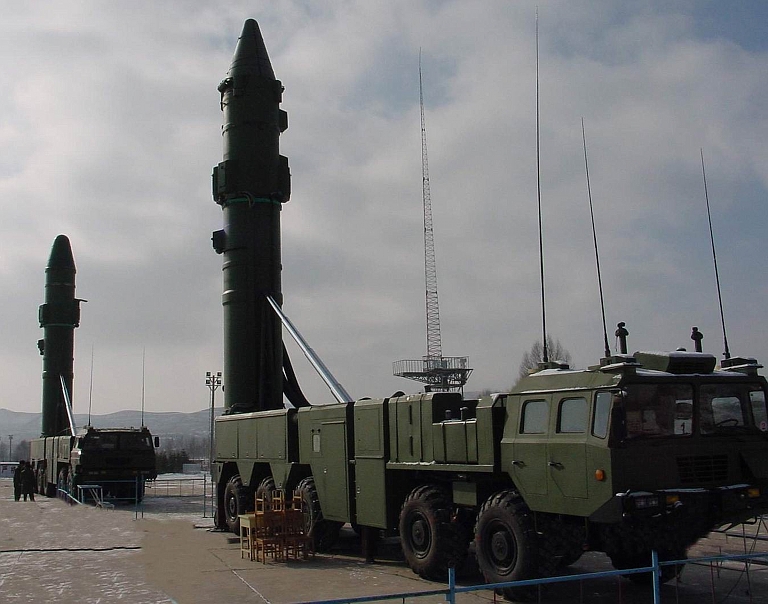
DF-21C TEL elevated for launch.
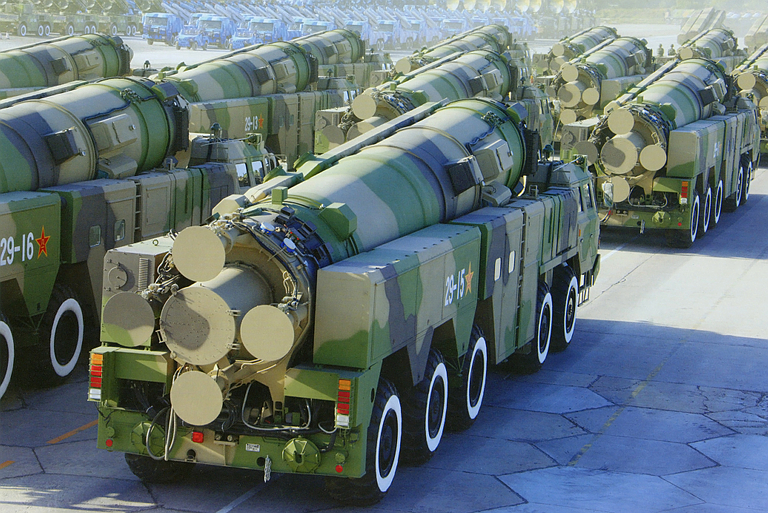
DF-21C TEL.
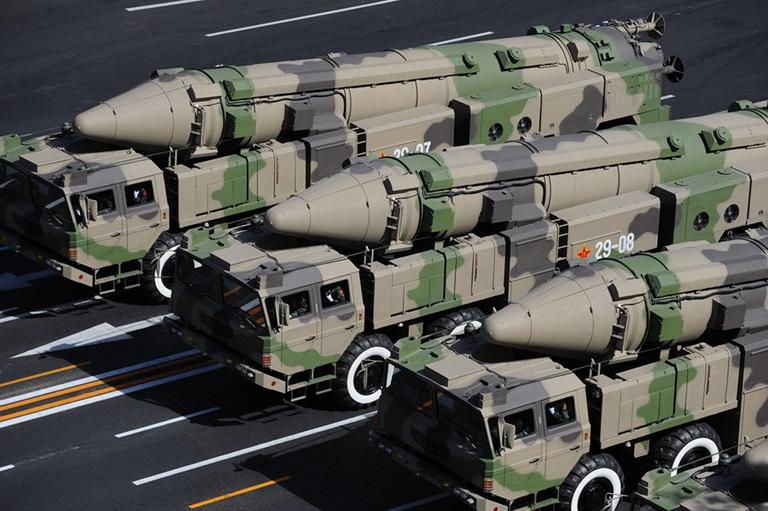
DF-21C TEL.
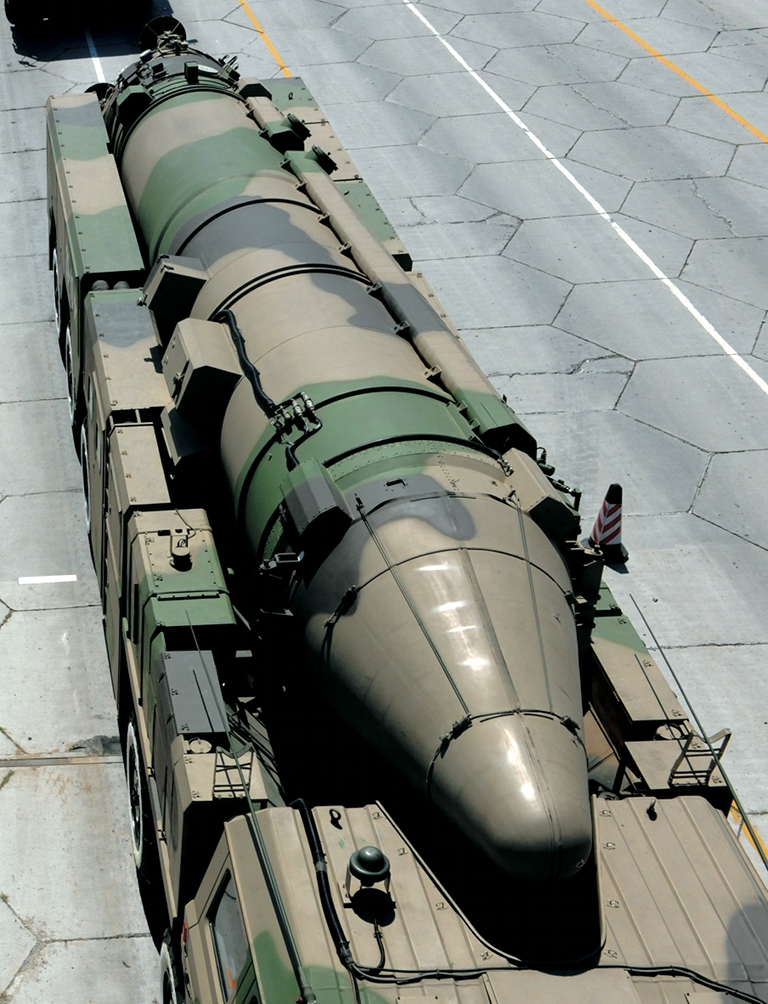
DF-21C.
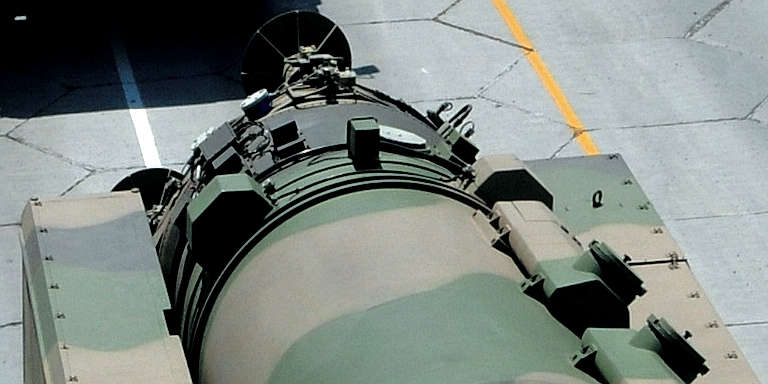
DF-21C.
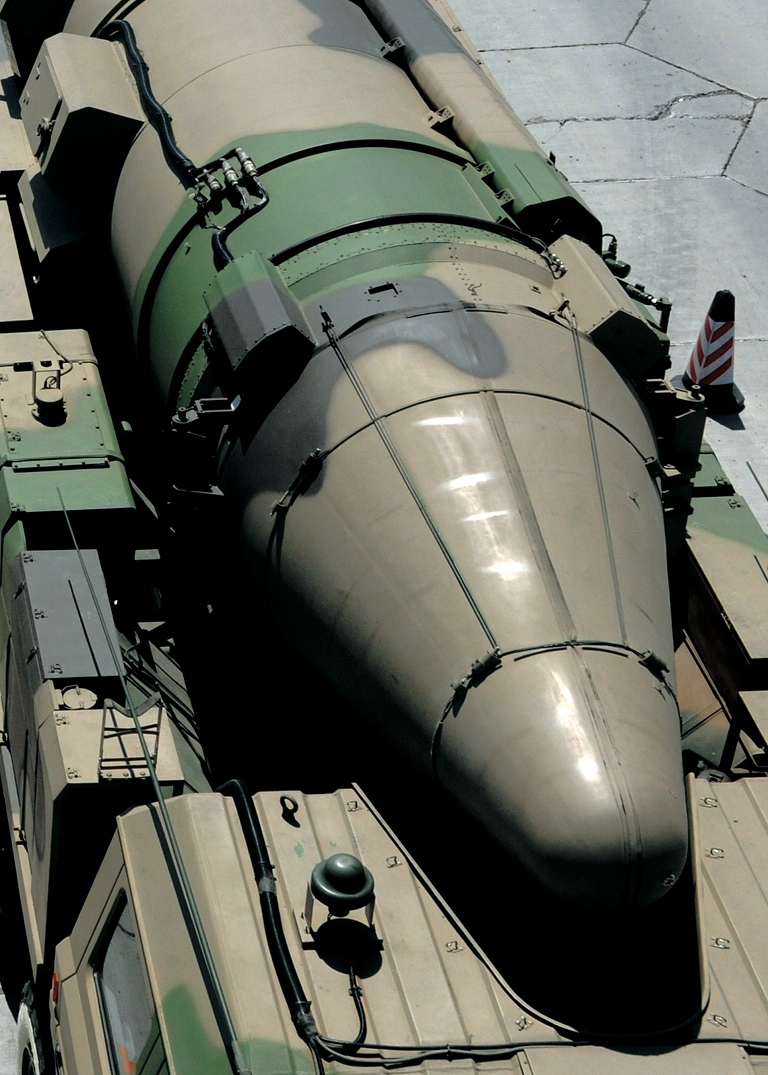
DF-21C.
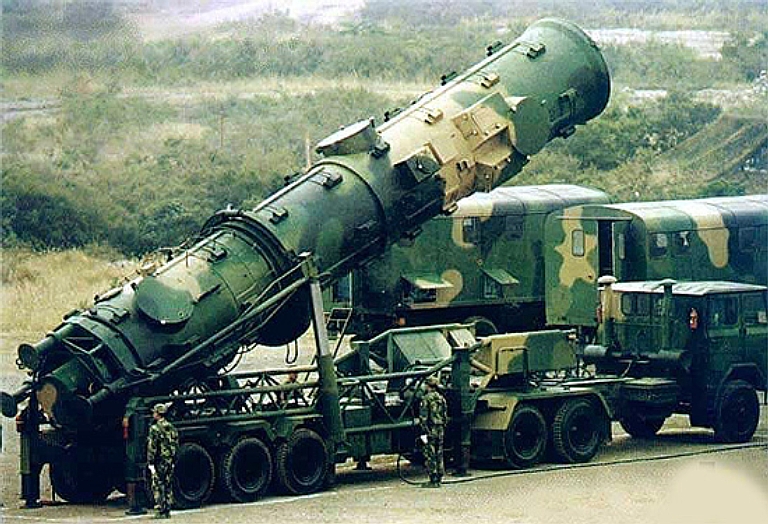
DF-21/21A TEL.
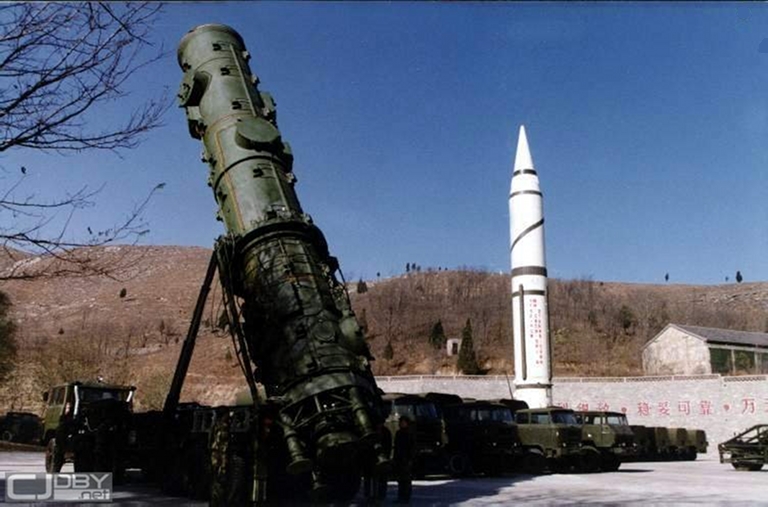
DF-21/21A TEL.
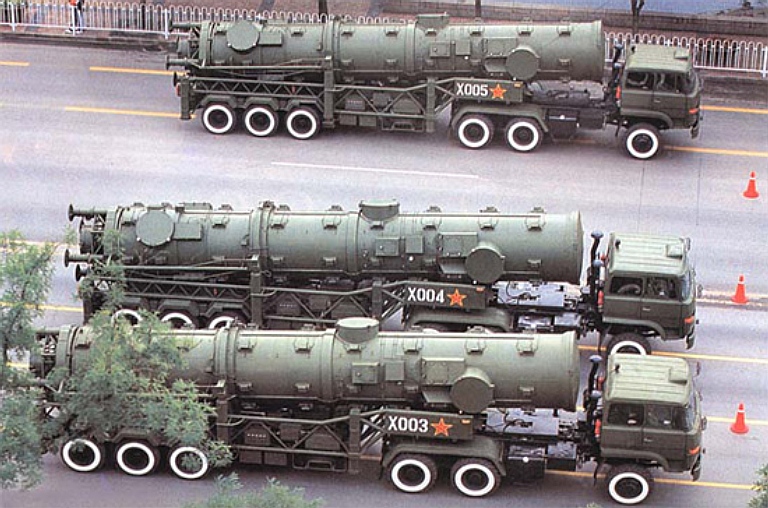
DF-21/21A TEL.
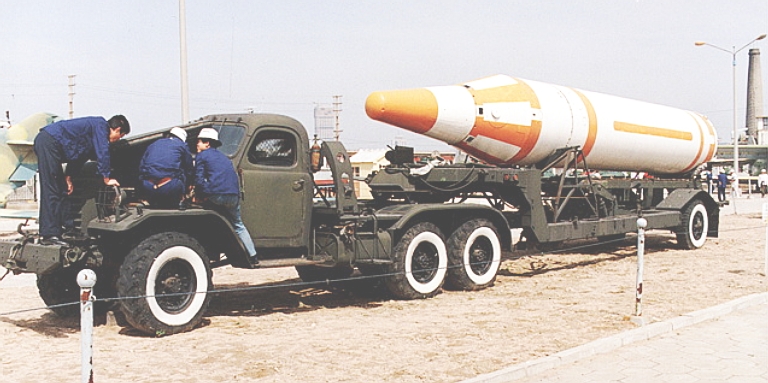
JL-1 SLBM on towed transporter.
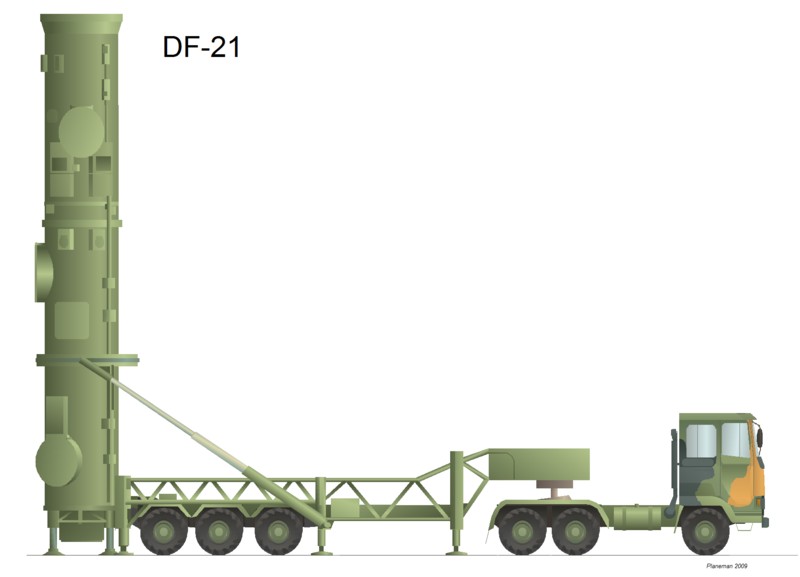
Early road mobile DF-21/21A TEL.

While the US DoD still credits the PLA with an operational DF-3A capability of 5-10 launchers and 15-20 missiles, the system is arguably more significant for having been exported to Saudi Arabia in a conventionally armed version.
| Principal Specifications | Notes1 | |
| Category |
IRBM
semi-mobile |
DF-3A
IOC
1987 |
| Maximum
Range
[km] |
2,810
or
greater |
|
| Apogee
[km] |
~500.0 |
|
| Vehicle Guidance | Inertial |
|
| RV
CEP
@
Maximum
Range
[m] |
0.87 |
|
| RV
Warhead
Type
/
Mass
[-/kg] |
1
x
3.3
MT
/
2,140.0 |
|
| Configuration |
Single
Stage
Liquid
Propellant |
|
| Length,
Total
[m] |
24.0 |
|
| Span,
Total
[m] |
2.74 |
|
| Launch
Weight,
Total
[kg] |
63,843.0 |
|
| First
Stage
Length |
24.0 |
|
| First
Stage
Mass,
Launch/Empty
[kg] |
64,100.0
/
4,100.0 |
|
| First
Stage
Motor
Type/Config |
4
x
YF-2A
/
Liquid
Propellant
Rocket |
|
| First
Stage
Propellant |
AK-27F/UDMH |
|

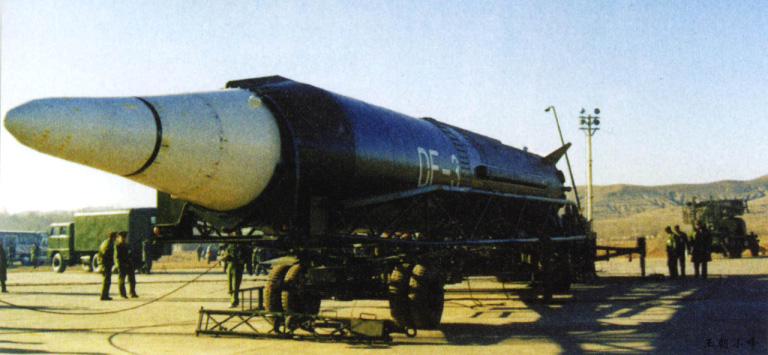
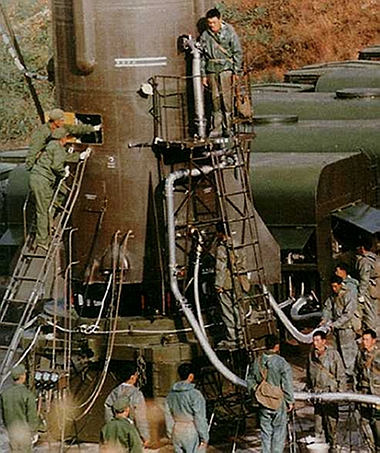 |
 |
|
| Prelaunch
preparations
-
fuelling
and
warhead
mating. |
||



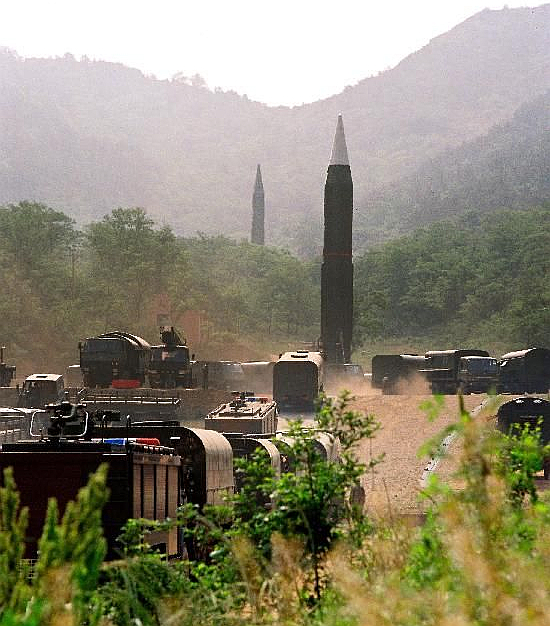
DF-2A / CSS-1
Tactical/Theatre Ballistic Missiles
DF-15 / M-9 / CSS-6
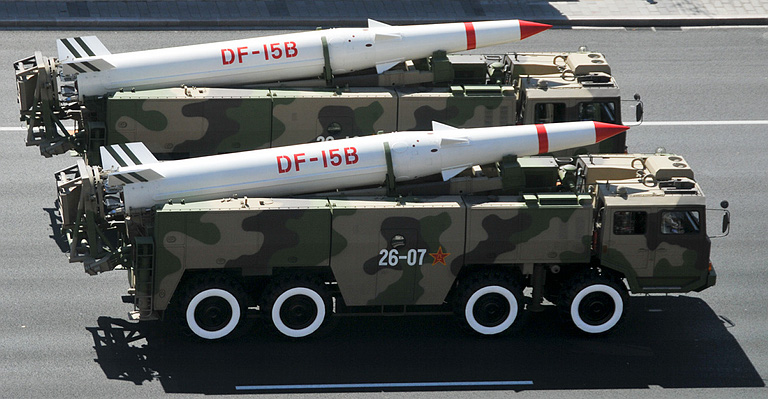
The DF-15B and DF-15C are two-stage modifications of the original DF-15. The revised nosecone of the DF-15B variant and presence of cruciform tail surfaces has led to frequent claims that the DF-15B has a terminal guidance capability, the presence of a visible actuator mechanism on publicly displayed weapons suggests this is so. The DF-15C is identified by the inclusion of a new cylindrical nosecone possibly housing a new warhead or a terminal guidance system.
DF-15s are transported on TAS5450 or WS-2400 TELs conferring a high degree of mobility as well as off-road capability.
| Principal Specifications | Notes1 | |
| Category |
TBM/IRBM |
|
| Maximum
Range
[km] |
605.0 |
|
| Apogee
[km] |
~100.0 |
|
| Vehicle Guidance | Inertial |
|
| RV
CEP
@
Maximum
Range
[m] |
1.35 |
|
| RV
Warhead
Type
/
Mass
[-/kg] |
1
x
20
kT
/
950.0 |
Conventional
or
nuc |
| Configuration |
Single
stage
solid
propellant |
|
| Length,
Total
[m] |
9.0 |
|
| Span,
Total
[m] |
1.0 |
|
| Launch
Weight,
Total
[kg] |
6,200.0 |
|

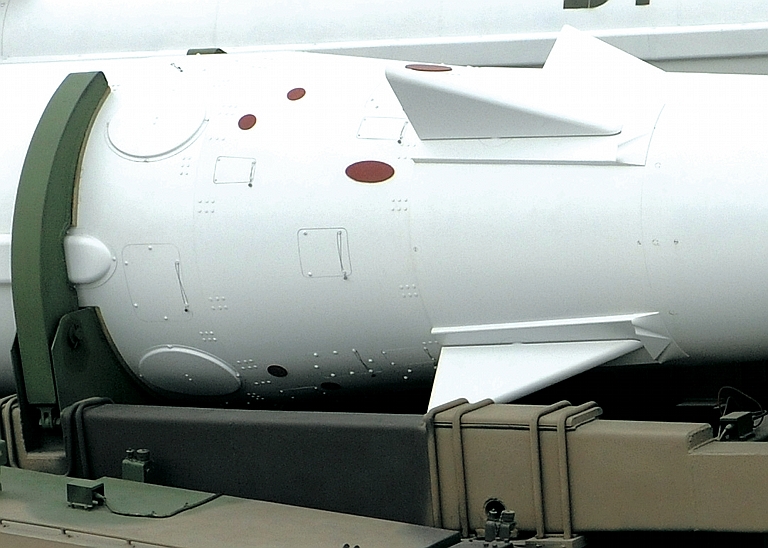

DF-15B TEL.
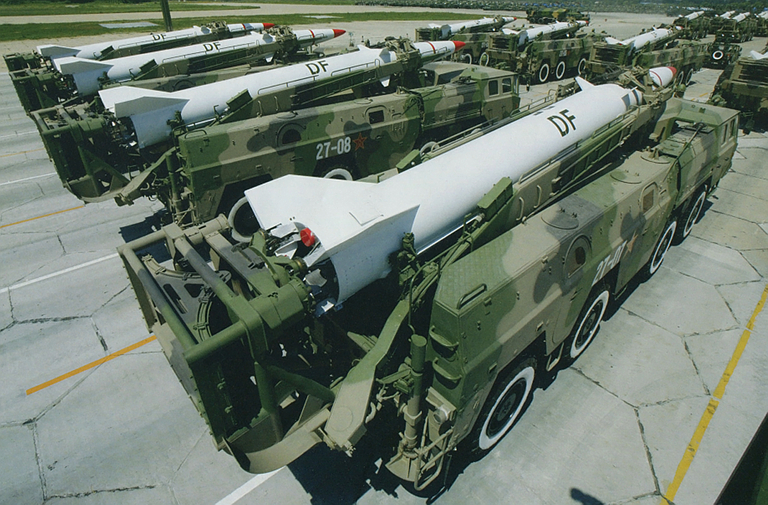
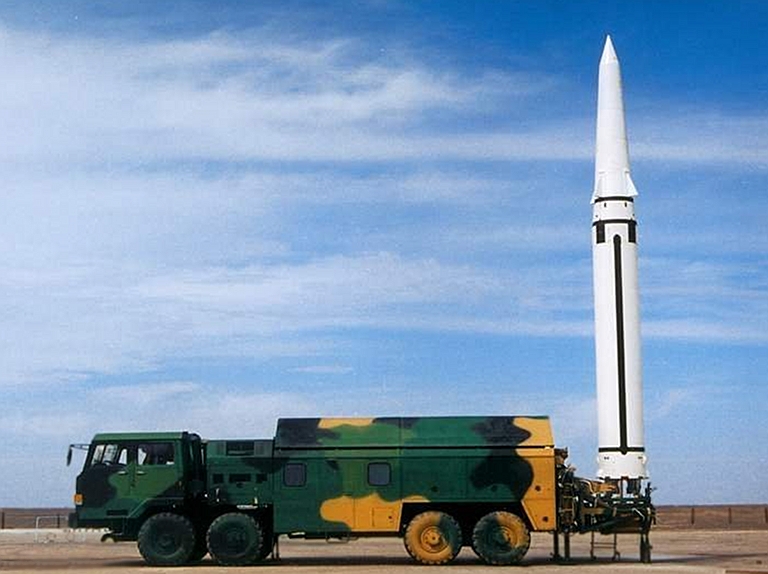
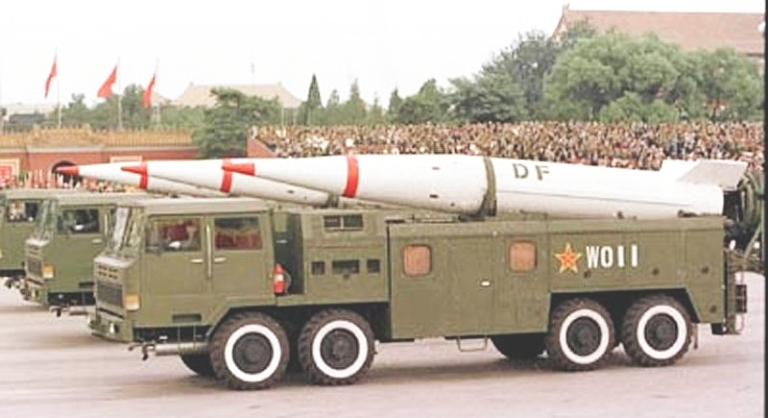
DF-15A TEL.
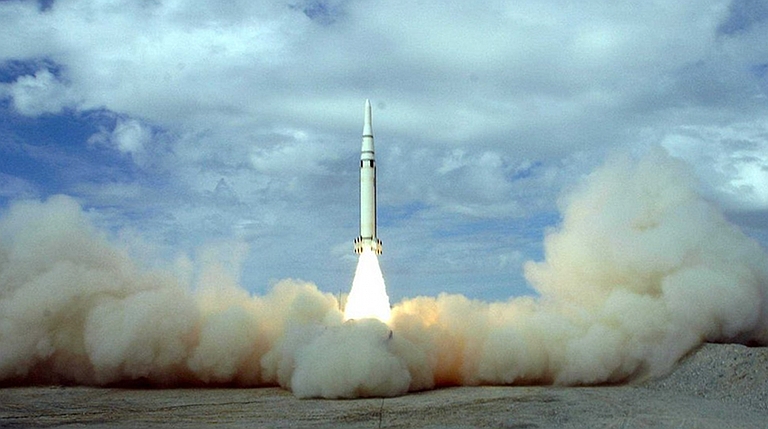
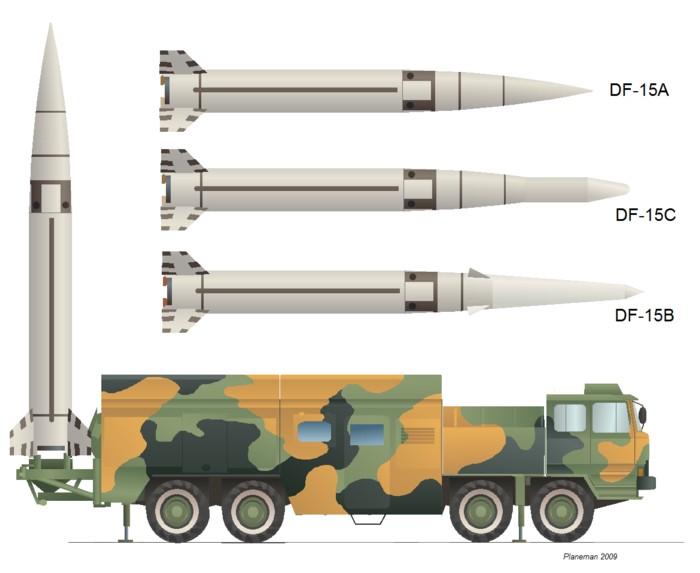
DF-11 / M-11 / CSS-7
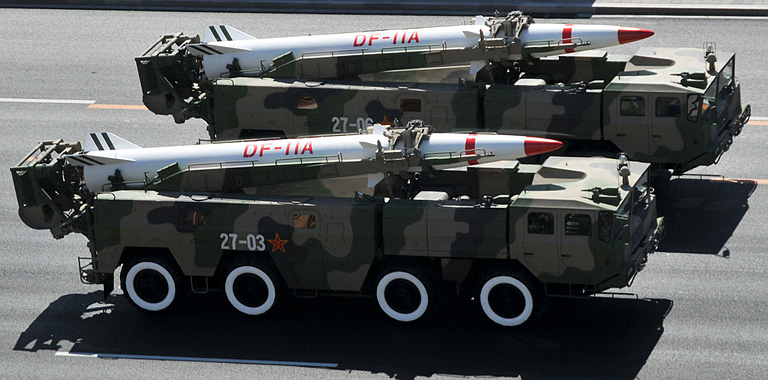
DF-11 TEL on WS-2400 chassis (PLA).
| Principal Specifications | Notes1 | |
| Category |
TBM |
|
| Maximum
Range
[km] |
300.0 |
|
| Apogee
[km] |
~150 |
|
| Vehicle Guidance | Inertial |
|
| RV
CEP
@
Maximum
Range
[m] |
- |
|
| RV
Warhead
Type
/
Mass
[-/kg] |
- |
|
| Configuration |
Single
stage
solid
propellant |
|
| Length,
Total
[m] |
7.4 |
|
| Span,
Total
[m] |
0.88 |
|
| Launch
Weight,
Total
[kg] |
6,300.0 |
|

Detail of DF-11, partially elevated.

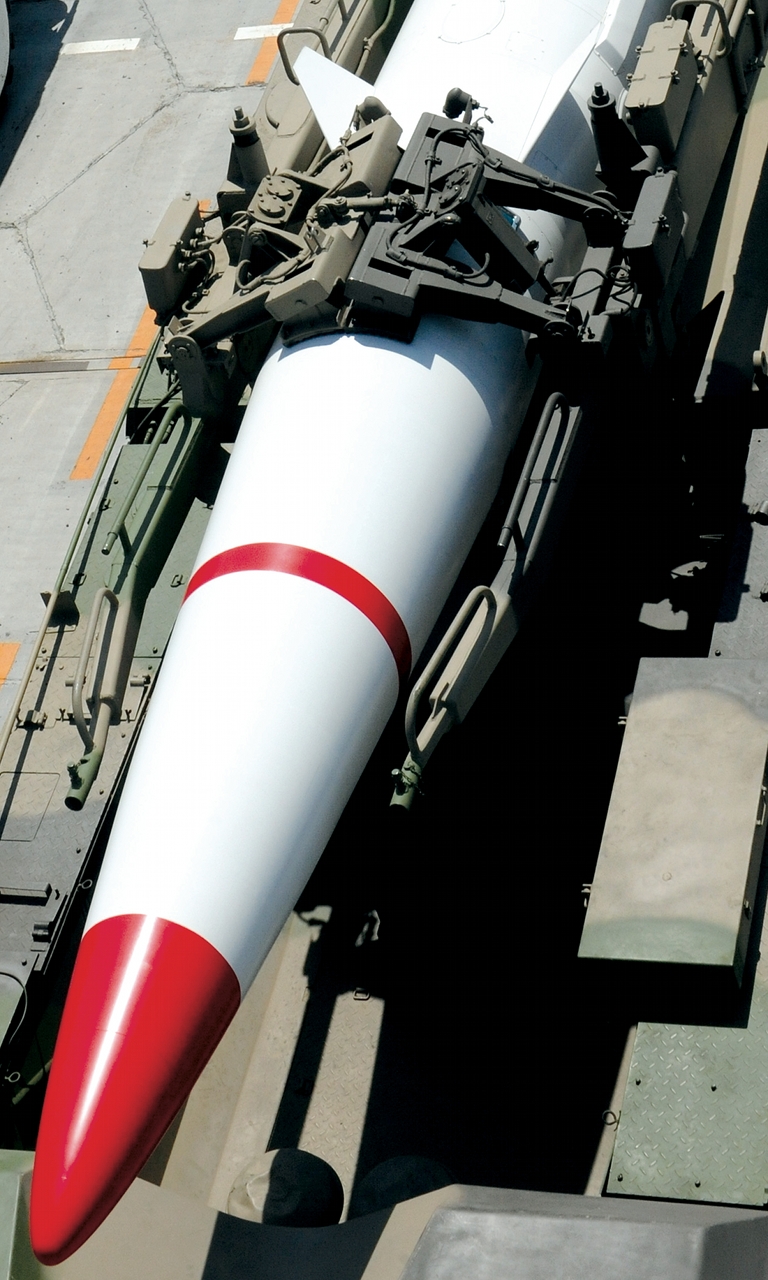
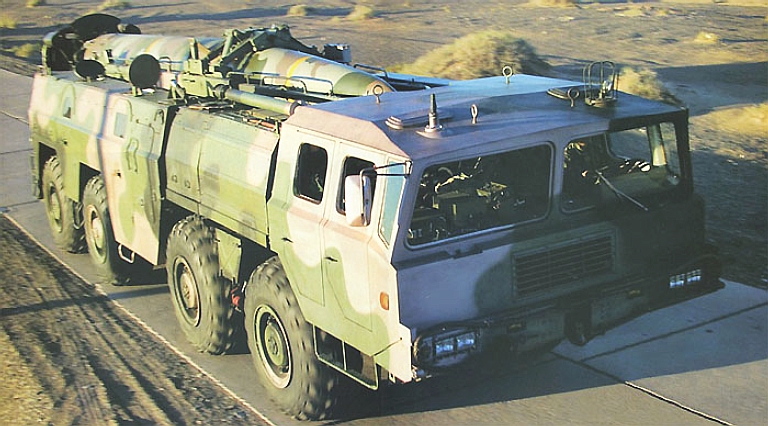
DF-11 TEL fully stowed.
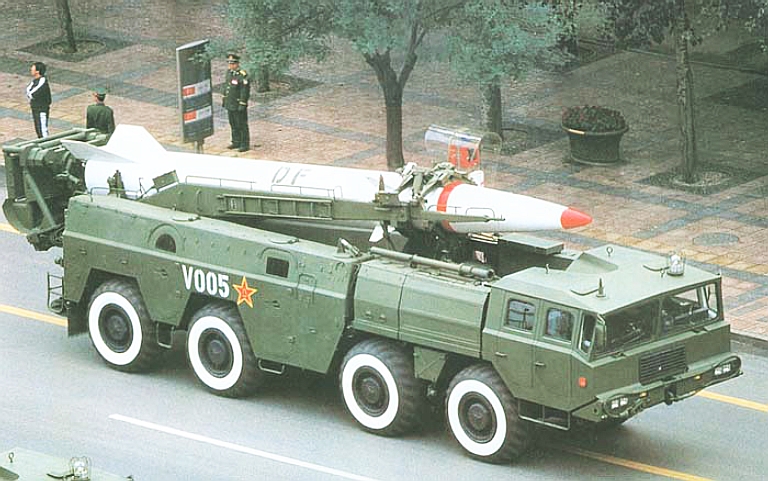
DF-11, partially elevated.
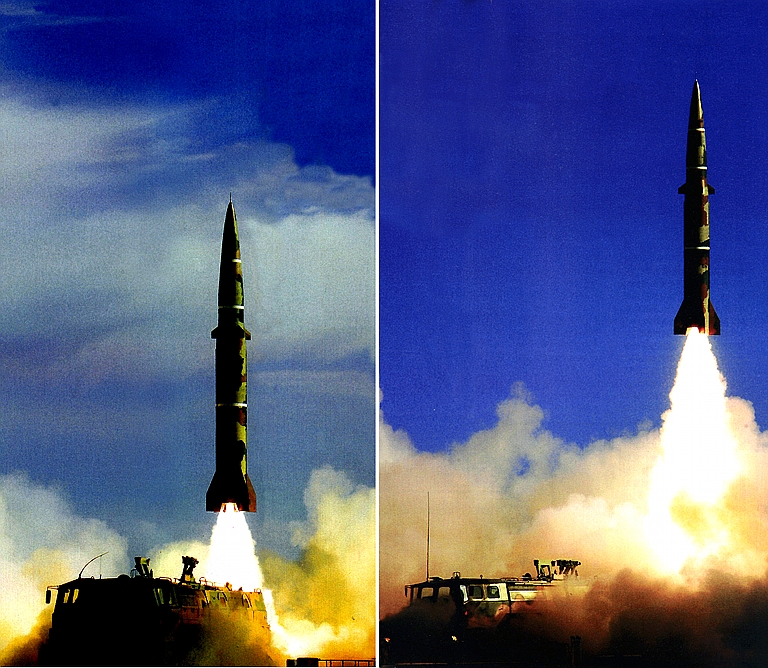

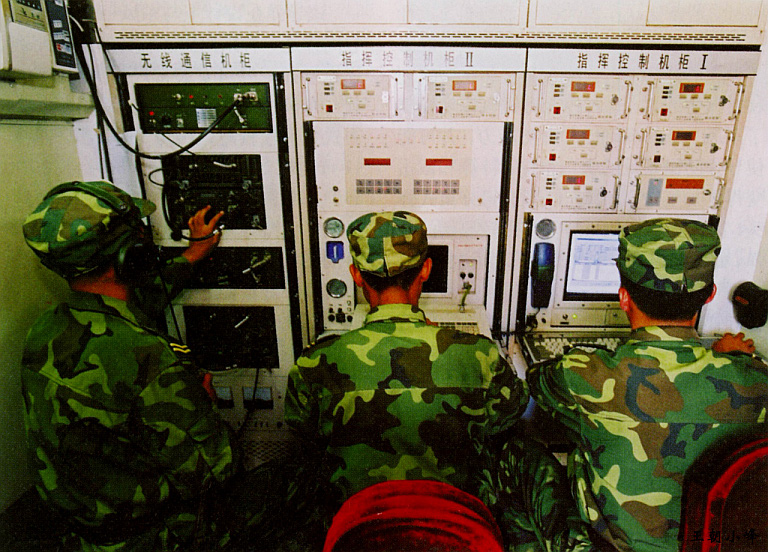
DF-11 TEL LCC consoles.

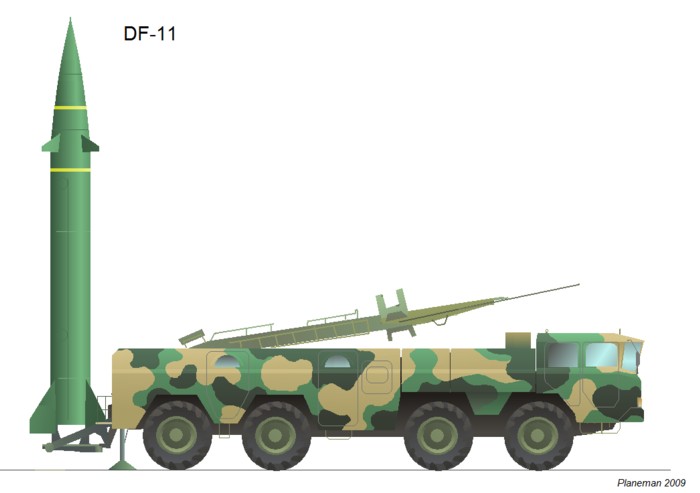

| Principal Specifications | Notes1 | |
| Category |
TBM |
|
| Maximum
Range
[km] |
~250.0 |
|
| Apogee
[km] |
||
| Vehicle Guidance | ||
| RV
CEP
@
Maximum
Range
[m] |
||
| RV
Warhead
Type
/
Mass
[-/kg] |
||
| Configuration |
||
| Length,
Total
[m] |
||
| Span,
Total
[m] |
||
| Launch
Weight,
Total
[kg] |
||
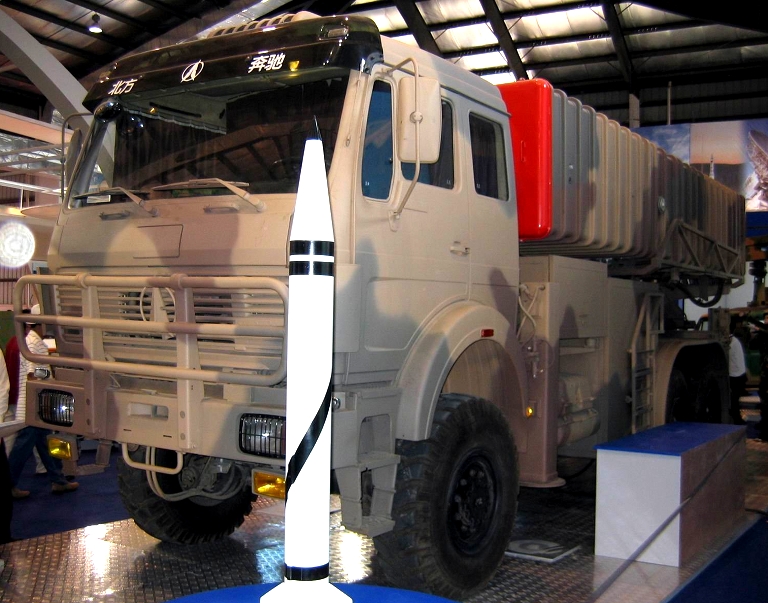
Notes/References
- Specifications sourced from Encyclopedia Astronautica, URI: http://www.astronautix.com/index.html; and federation of American Scientists online database, URI: http://www.fas.org/nuke/guide/china/index.html.
- Other designations include the export M-7 and M-18. No information exists on the identity of these weapons, although one designation may be applied to the 8610.
- No information exists as to when the switch was made from the designation DF-25 to DF-21C, nor does information exist as to what the "missing" DF-21B may have been.
- US DoD Military Power of the People's Republic of
China (2008, 2009)
- US DoD Military and Security Developments Involving
the People's Republic of China (2010)
- NASIC Ballistic and Cruise Missile Threat (2009)
- Dr. Martin Andrew, Hot Brief: Chinese Strategic
Cruise and Ballistic Missiles (2010)
- John Wilson Lewis and Hua Di, China's Ballistic
Missile Programs, International Security, Fall 1992)
- AFSC Foreign Technology Division, China's Ballistic Missile Plans (Ma Ke and Wei De Yuan Zuo, translated from Hangkong Zhishi, April 1981).
- Line artwork courtesy Planeman.
- Imagery Sources: Xinhua; PLA-AF; MilitaryPhotos.net;
other Internet sources.

Technical Report APA-TR-2010-0802
|
|||||||||||||
![Sukhoi PAK-FA and Flanker Index Page [Click for more ...]](APA/flanker.png) |
![F-35 Joint Strike Fighter Index Page [Click for more ...]](APA/jsf.png) |
![Weapons Technology Index Page [Click for more ...]](APA/weps.png) |
![News and Media Related Material Index Page [Click for more ...]](APA/media.png) |
||||||||||
![Surface to Air Missile Systems / Integrated Air Defence Systems Index Page [Click for more ...]](APA/sams-iads.png) |
![Ballistic Missiles and Missile Defence Page [Click for more ...]](APA/msls-bmd.png) |
![Air Power and National Military Strategy Index Page [Click for more ...]](APA/strategy.png) |
![Military Aviation Historical Topics Index Page [Click for more ...]](APA/history.png)
|
![Information Warfare / Operations and Electronic Warfare Index Page [Click for more ...]](APA/iw.png) |
![Systems and Basic Technology Index Page [Click for more ...]](APA/technology.png) |
![Related Links Index Page [Click for more ...]](APA/links.png) |
|||||||
![Homepage of Australia's First Online Journal Covering Air Power Issues (ISSN 1832-2433) [Click for more ...]](APA/apa-analyses.png) |
|||||||||||||
| Artwork, graphic design, layout and text © 2004 - 2014 Carlo Kopp; Text © 2004 - 2014 Peter Goon; All rights reserved. Recommended browsers. Contact webmaster. Site navigation hints. Current hot topics. | |||||||||||||
|
Site Update
Status:
$Revision: 1.753 $
Site History: Notices
and
Updates / NLA Pandora Archive
|
|||||||||||||
|
|
Tweet | Follow @APA_Updates | |||||||||||
|
|
|||||||||||||
|
|
|||||||||||||
![F-111 Aardvark Index Page [Click for more ...]](APA/f-111.png)
![F/A-18 Hornet and Super Hornet Index Page [Click for more ...]](APA/fa-18a.png)
![Aerial Refuelling and Airlift Capabilities Index Page [Click for more ...]](APA/aar-lift.png)
![Directed Energy Weapons and Electromagnetic Bombs Index Page [Click for more ...]](APA/dew.png)
![Notices and Updates Index Page [Click for more ...]](APA/notices-128.png)
![APA NOTAM and Media Release Index Page [Click for more ...]](APA/notams-128.png)
![APA Research Activities and Policy / Technical Reports Index [Click for more ...]](APA/research-128.png)
![Search Air Power Australia Website [Click for more ...]](APA/search-128.png)
![Briefings and Submissions - Air Power Australia [Click for more ...]](APA/briefs-128.png)
![Air Power Australia Contacts [Click for more ...]](APA/contacts-128.png)
![Funding Air Power Australia [Click for more ...]](APA/funding-258.png)
